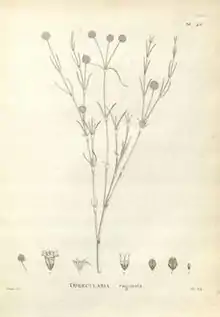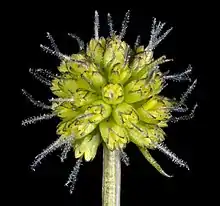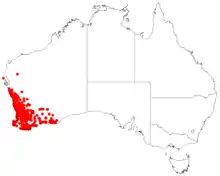Opercularia vaginata
Opercularia vaginata (dogweed) is a species of plant within the genus, Opercularia, in the family Rubiaceae. It is endemic to the southwest of Western Australia.[4]
| Opercularia vaginata | |
|---|---|
 | |
 | |
| Scientific classification | |
| Kingdom: | Plantae |
| Clade: | Tracheophytes |
| Clade: | Angiosperms |
| Clade: | Eudicots |
| Clade: | Asterids |
| Order: | Gentianales |
| Family: | Rubiaceae |
| Genus: | Opercularia |
| Species: | O. vaginata |
| Binomial name | |
| Opercularia vaginata | |
 | |
| Collections data from AVH | |
| Synonyms[3] | |
|
Opercularia multicaulis Bartl. | |
Description
O. vaginata is a spreading or erect perennial which grows to a height of 0.45 m on sandy, granitic and lateritic soils, and coastal limestone.[5] Its green or green-yellow flowers are seen from July to December.[5]
Distribution
It is found in Beard's provinces of Eremaean Province and the South-West Province, or the later classification of IBRA regions of Avon Wheatbelt, Coolgardie (biogeographic region), Esperance Plains, Gascoyne, Geraldton Sandplains, Jarrah Forest, Mallee (biogeographic region), Murchison (biogeographic region), Swan Coastal Plain, Warren and Yalgoo (biogeographic region).[5]
Taxonomy
It was first described by Jacques Labillardiere in 1804 as Opercularia vaginata in de Jussieu's Annales du Muséum d'histoire naturelle.[1][2]
References
- "'Australian Plant Name Index (APNI): Opercularia vaginata". IBIS database. Centre for Plant Biodiversity Research, Australian Government. Retrieved 1 August 2018.
- Labillardiere,J. in de Jussieu, A.L. (1804) Annales du Muséum d'histoire naturelle. 4:428
- Govaerts, R., et. al. 2018. "Plants of the World online: Opercularia vaginata". Board of Trustees of the Royal Botanic Gardens, Kew. Retrieved 1 August 2018.
- "AVH: Opercularia vaginata (mapview), Australasian Virtual Herbarium". Retrieved 1 August 2018.
- "FloraBase: Opercularia vaginata". Western Australian Herbarium, Biodiversity and Conservation Science, Department of Biodiversity, Conservation and Attractions. Retrieved 1 August 2018.